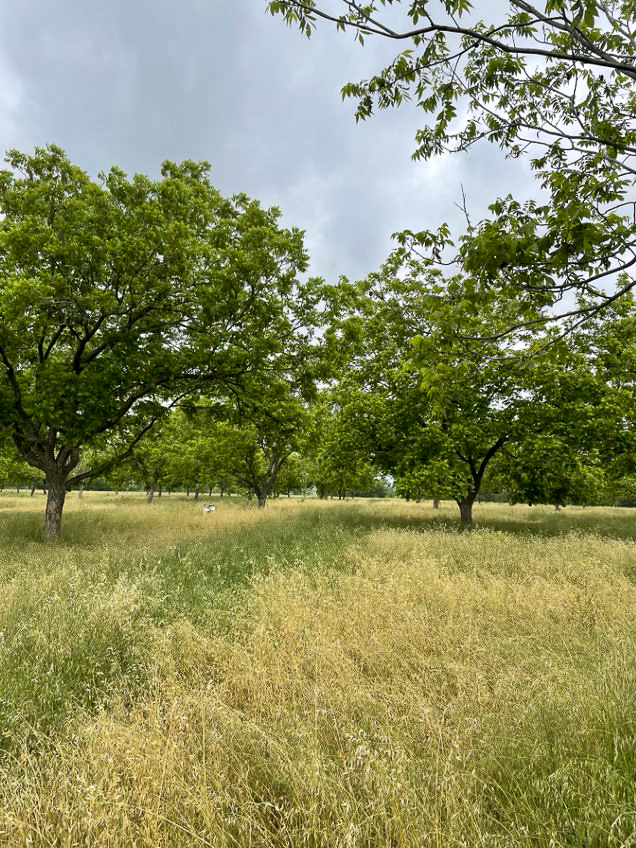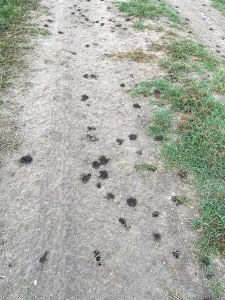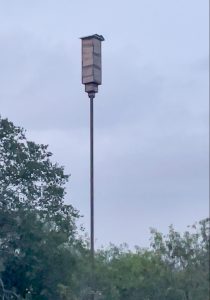Regenerative Management in Pecans

Having a variety of species of forages growing in the orchard help feed the microbes in the soil resulting in healthier soils. (Photo by Lauren Jones, Noble Research Institute)
- Building soil organic matter and diversity
- Healthier and more productive soil that is drought and flood resilient
- Decreased use of chemical inputs and subsequent pollution
- Cleaner air and water
- Enhanced wildlife habitat (especially beneficial wildlife)
- Production of higher nutritional foods
- Capturing carbon in the soil to combat climate change
Typically, we think about regenerative agriculture management in rangeland or cropland. However, the same principles can be applied to both improved and native pecans. The key to promoting regenerative agriculture in pecans is to understand the principles of pecan production and add practices that promote regenerative agriculture following the soil health principles.
We know through traditional research that controlling grass and weeds around the base of the tree increases the growth of young trees and production on mature trees; trees respond to applications of fertilizer and irrigation, and that insect and disease control with chemicals is recommended to maximize production by protecting the crop. However, the studies that delivered these results only looked at soil type. The research did not look into the health of the soil.
I know that the studies that evaluated a vegetation-free area around the tree, resulting in increased growth and higher production, were done on sandy soils with a low organic matter and monoculture grass growing between the trees. We should consider what would happen if these studies were conducted in healthier soils with higher organic matter and a diverse forage base growing between the trees. Would the results be the same?
Several other management studies have been conducted over the years where researchers do their best to limit variables so that we are evaluating the fewest variables possible. By doing so, we have not considered the interactions of these variables in nature and how removing one variable may interfere with the performance of the variable we are looking at. It is imperative to look at the system as a whole and not to break it down into individual components because that is not how nature works. As growers, we should look at alternative practices that follow the soil health principles to promote healthier soils. Growing legumes between tree rows have been shown to add nutrients, especially nitrogen, to the soil. However, we also know through research outside of pecans that having a good variety of species (grasses, legumes, broadleaf, forbs) in both the cool season and warm season helps feed the microbes in the soil, resulting in healthier soils and more available nutrients for the crop that we are growing. Increasing organic matter and utilizing cover crops (either planted or naturally occurring) under the trees to create a thick thatch layer to conserve moisture helps lower the irrigation requirement and increases organic matter, resulting in higher water holding capacity and nutrient load in the soil. Utilizing integrated pest management principles helps reduce the need for chemical application by only applying a treatment when required. Treatments do not always have to be a traditional chemical treatment; there are new treatments that may have the same control on the pest with fewer environmental impacts. Using cover crops that attract beneficial insects can reduce the need for insecticides. Looking at alternative pecan control methods, such as releasing beneficials or using bats or birds to control insects, will help improve the ecosystem and reduce in fewer inputs. Therefore, pecan production can be regenerative agriculture. Let’s examine further how pecans fit as a regenerative crop.
Building soil organic matter and diversity:
Organic matter serves as a reservoir of nutrients for plants, provides soil aggregation, increases nutrient exchange and moisture retention, reduces soil compaction, reduces surface crusting, and increases water infiltration. Pecan trees deposit a lot of organic material onto the soil. Along with the grass growing under the trees, typically, around 5,500 to 8,000 pounds of leaves and shucks are deposited back into the soil each year, which helps increase organic matter. Using clovers or cover crops in the rows of the orchards will increase the organic matter levels and can provide an additional 3,500 or more dry matter per acre.

Observing worms in the soil is a great sign that the soil is healthy. These wormholes were located in the roads throughout one of the orchards following regenerative principles. Seeing all these worms on the compacted soils of the roads is a great sign of what is occurring in the orchards. (Photo by Charles Rohla)
Wells (2009) indicated that the average soil organic matter in the Southeastern Coastal Plain ranged from 0.5 to 2%; however, pecan orchards in that region averaged 3.6%. Most pecan orchards are naturally diverse with multiple varieties and ages of pecan trees. The combination of grasses, legumes, and weeds in between the trees’ understory adds additional diversity. Native pecan groves have far more diversity because each tree is genetically different, and most native groves have native forage growing under the trees, and livestock is utilized to manage the understory. Adding diversity under the trees dramatically increases the food source for the below-ground microorganisms.
Healthier and more productive soil that is drought and flood resilient:
Pecans are typically grown in well-drain, deep, productive soils that are naturally drought and flood resilient. Pecans have a massive, deep penetrating root system that spans up to three times the height of the tree in each direction from the trunk and as deep as the water table or impermeable soil layer. This root system structure enables the pecans to be more drought and flood tolerant than other plants. The use of cover crops would be beneficial in pecan production to help increase water infiltration, nutrient cycling, and water management, thus improving the health of the soil. Limiting the chemical inputs and increasing plant diversity within the orchard will increase microbial activity increasing soil health. With increased soil health, mycorrhizal populations and their association with pecan trees will increase. Since pecan trees do not have root hairs, this increased association with mycorrhizal results in greater water and nutrient uptake by the trees, especially phosphorus and zinc.
Decreased use of chemical inputs and subsequent pollution:
Planting new orchards with more disease-resistant cultivars and incorporating cover crops into the orchards will help reduce chemical inputs. Cover crops can increase nutrient levels in the soil and attract beneficial insects. Growers can also reduce chemical inputs by understanding pecan scab and learning when the best time to spray is and if spraying is required. As for pest control, utilizing integrated pest management (IPM) practices in pecans is the best way to reduce chemical use in pecan production, which entails only spraying when economically feasible.
The collection of tissue samples allows us to develop a fertilizer plan for next year. Along with the tissue sample, producers can use the Haney soil sample to determine nutrients in the soil, which will further help develop the following year’s proper fertilizer plan. Another option to reduce chemical inputs—alternative fertilizer sources provide additional nutrients, carbon, and microbes to the soil, help regenerate the soil health, and provide build a long-term nutrient plan for your trees. Utilizing a split application of the planned amount will ensure that we are not over-fertilizing the trees when there is a small crop. This plan will also help regulate the tree’s growth and should help with nut production.
Cleaner air and water:
Trees are an excellent natural way to clean air and water. Pecan roots help hold the soil, and their leaves and canopy buffer the soil against wind and rainfall impact, lessening erosion. A study in Florida showed that when cotton was grown in between pecan trees, there was a reduction in nitrate seeping into groundwater by two-thirds as compared to cotton growing alone. The pecans’ deep roots could take up the nitrates that leached below the cotton roots. Mexal (2003) showed that for every unit of carbon dioxide removed from the atmosphere more than 1 pound of oxygen is generated. Hartman (2000) identified the following benefits of trees to a community:
- One acre of trees traps over 500 pounds of pollutants, including over 200 pounds of ozone and 150 pounds of particulates.
- Supplies oxygen
- Sequesters carbon dioxide
- Reduces noise pollution
- Traps particulates
- Alters microclimates
- Improves aesthetics
- Enhances outdoor urban spaces
- Alters the community’s character
Enhanced wildlife habitat:

Some growers are looking at using bats as an alternate pest control method in the orchard to help control Pecan Nut Casebearer and Hickory Shuckworms. There is a potential that bats may help with other insects in the orchard too. (Photo by Charles Rohla)
Pecan orchards also provide habitats for nesting birds and other species, and sources of nectar for pollinators. In fact, a survey by Wells in 2012 identified over 202 species (plants, fungi, birds, insects, reptiles, mammals, mollusks, and amphibians) in pecan orchards in the Southeast. In a Texas survey titled “Spiders in Pecans in Central Texas,” 162 species of spiders from 26 families were documented (important natural enemies of pecan pests).
Capturing carbon in the soil to combat climate change:
Mexal (2003) calculates that nearly 1.5 units of carbon dioxide are removed from the atmosphere for every unit of carbohydrate a pecan tree creates. Furthermore, 49% remains captured in the tree, 30% goes back into the soil as organic matter, and about 10% is removed with the crop, which is then consumed. According to Mexal, the New Mexico-West Texas pecan industry, with around 2 million trees, removes 560 million pounds of carbon dioxide each year, roughly equivalent to 41,500 vehicles driving 15,000 miles per year.
According to the United States Department of Agriculture (USDA), there are over 550,000 acres of managed pecans in the U.S. with approximately 9.4 million trees, using the FSA assumption that there are 17 trees per acre (a gross underestimate of the number of trees in the West and young orchards throughout the South). Using 180 pounds of carbon dioxide captured per tree per year, there are nearly 850,000 tons of carbon dioxide captured yearly in pecan trees (over 1.5 tons per acre). According to the Savory Institute, the 761 million acres of rangelands in the United States captures 198 million tons (0.26 tons/acre). Also, with an average production of 265 million pounds per year in the U.S., there would be around 9,200 tons of carbon dioxide captured in the kernels that are consumed. Industries that have a “Life Cycle Analysis” (carbon footprint) have determined the carbon emissions from their industries:
- Almonds – 1 kilogram of carbon emissions
- Beef – 20 kilograms of carbon emissions
- Vegetables – 2 kilograms of carbon emissions
The pecan industry does not have a life cycle analysis; however, it should be like almonds, with the exception that the pecan industry does not manufacture by-products from production waste as almonds do. Though, this is an area that needs further exploration. One fact that could help lower carbon emissions compared to almonds is that pecan trees are long-lived. Almond trees are typically removed after 25 years, but pecan trees can live for hundreds of years.
Regenerative agriculture can be utilized in pecan production. Several practices need further research to fully understand the system interaction and impact on soil health, tree growth, nut production, and insects and disease. Several growers are already implementing some of these studies in their operations. One caveat with following soil health principles is that what may work at one location may not have the same results at a different location. Not all soils are the same or at the same health status; the micros at one site may be different than at another, impacting the results of using different practices. We encourage producers to start small, select an area to try different techniques and evaluate the results. Then move to larger areas as you see beneficial results occur. The other important thing to keep in mind is to give this new management strategy time; in some instances, you are trying to correct a problem that has been occurring for years, and it may take time to correct it.

